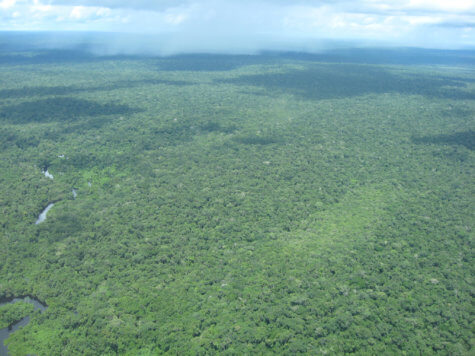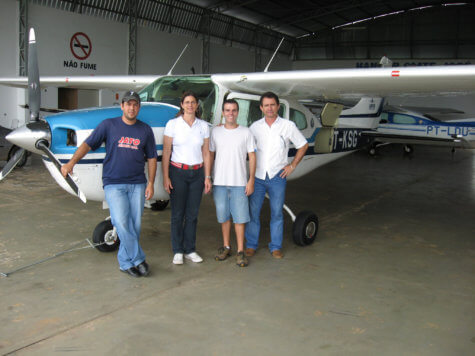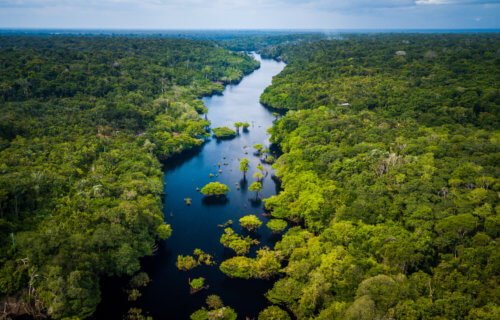SÃO JOSÉ DOS CAMPOS, Brazil — The world’s biggest rainforest, the Amazon, has long been one of the Earth’s greatest natural resources for absorbing carbon dioxide. Now, a new report finds this key tool in the fight against global warming may actually be fueling rising temperatures in recent years.
How could this possibly be the case? An international team says deforestation (or clearing out trees) is at the heart of this concerning shift. Due to logging and fires, a fifth of the Amazon area is now emitting more carbon than it absorbs. This is turning it into a giant greenhouse gas source. This has alarming implications for the fight against climate change, researchers warn.
“Each year it’s getting worse,” says lead author Professor Luciana Gatti from Brazil’s National Institute for Space Research in a statement to SWNS.
Millions of trees have recently been lost to clearcutting and fires. Normally, these tress suck CO2 from the sky as they grow and release it when they die.
“Deforestation and regional climate change is threatening the atmospheric carbon buffering potential of the rainforest,” Prof. Gatti adds.

Is Earth losing its greatest carbon sink?
Amazonia represents the greatest expanse of tropical forest on the planet. The shimmering green leaves play a vital role in storing atmospheric carbon. They convert it through photosynthesis into carbohydrates that end up in the wood trunks and branches.
The study in the journal Nature sheds fresh light on the influence of humans on Earth’s largest carbon sink.
“Factors such as deforestation and climate change are thought to have stimulated a decrease in the capacity,” Prof. Gatti continues. “They have altered the local balance of carbon gases – which is indicative of the health of an ecosystem.”
The findings come from 590 observations of carbon dioxide and monoxide concentrations over nine years. Every two weeks, from 2010 to 2018, the researchers flew over four sites of the Amazon basin in aircraft fitted with sensors. They focused on the troposphere – the lowest layer of the atmosphere – up to three miles above sea level. Their study finds southeastern Amazonia – which makes up about 20 percent of the entire rainforest – is now a substantial source of CO2.
“Stress inflicted on local ecosystems and an increase in fire occurrence – promoted by an intensification of the dry season and deforestation – may be responsible for the higher emissions,” the lead author says. “Deforestation and climatic changes may have lasting, negative consequences for both the carbon balance of the region and the fragility of its ecosystems.”
Clearing out the Amazon rainforest is bringing the world closer to ‘tipping point’
Deforestation in Brazil hit a 12-year high in 2020, increasing nearly 10 percent from the year before. Normally, the Amazon slows the pace of global warming by storing up to 200 gigatons of carbon; the equivalent of five years worth of human emissions. Unfortunately, the researchers say it’s becoming a carbon source faster than feared.

At 2.72 million square miles, the rainforest is roughly the size of the United States, covering 40 percent of the South American continent. For decades, scientists have warned of an “Amazon tipping point,” where the region will lose its ability to renew itself. Estimates now show that more than half of the Amazon may become a savanna within the next 30 years.
“This carbon sink seems to be in decline as a result of factors such as deforestation and climate change,” Prof. Gatti explains. “We find total carbon emissions are greater in eastern Amazonia than in the western part, mostly as a result of spatial differences in carbon-monoxide-derived fire emissions. South eastern Amazonia, in particular, acts as a net carbon source to the atmosphere.”
“Over the past 40 years, eastern Amazonia has been subjected to more deforestation, warming and moisture stress than the western part, especially during the dry season, with the southeast experiencing the strongest trends,” Gatti adds.
“We explore the effect of climate change and deforestation trends on carbon emissions at our study sites, and find the intensification of the dry season and an increase in deforestation seem to promote ecosystem stress, increase in fire occurrence, and higher carbon emissions in the eastern Amazon. This is in line with recent studies that indicate an increase in tree mortality and a reduction in photosynthesis as a result of climatic changes across Amazonia.”
The uncertain future may already be here
Prof. Scott Denning, a climate scientist at Colorado State University who did not take part in the study, describes the results as “worrying.”
“Atmospheric measurements show that deforestation and rapid local warming have reduced or eliminated the capacity of the eastern Amazonian forest to absorb carbon dioxide,” Denning says. “Eastern Amazon sites have warmed by as much as about 0.6 °C per decade during the dry season over the past 40 years. This is more than three times the rate of global warming and about the same rate as for the Arctic.”
“The future of carbon accumulation in tropical forests has long been uncertain,” Denning concludes. “Gatti and colleagues’ atmospheric profiles show the uncertain future is happening now.”
SWNS writer Mark Waghorn contributed to this report.
